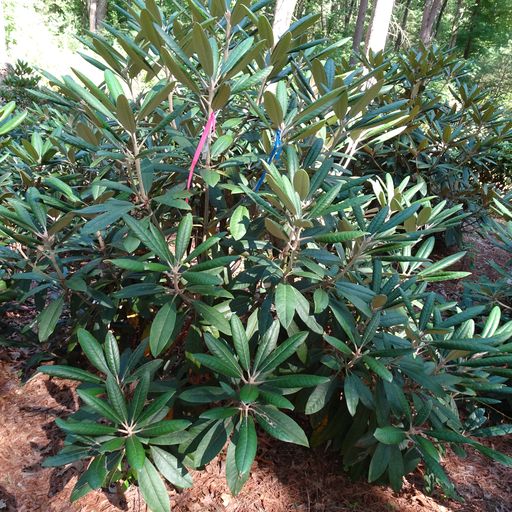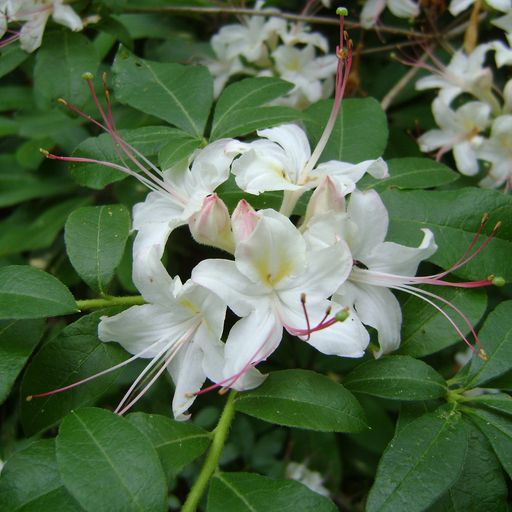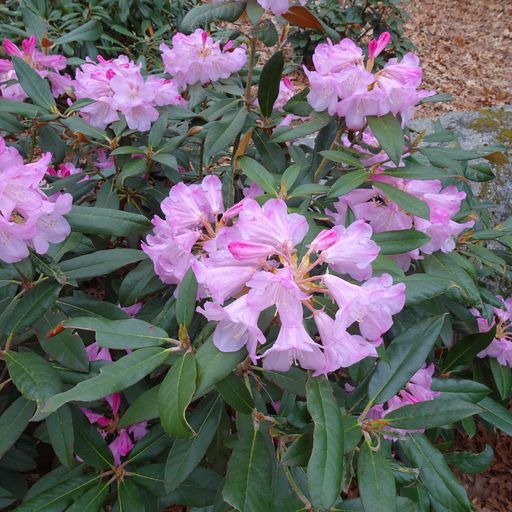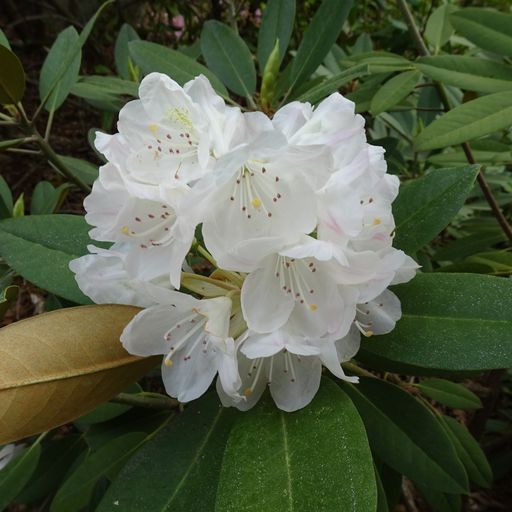Weston Nurseries is offering an opportunity that’s truly unique: full-size rhododendrons that instantly create that “mature garden” effect in your yard. This is your chance to find an unsurpassed collection of new and unusual rhododendron cultivars that are rarely (if ever) offered for sale anywhere.
Bred locally by Joe Bruso, an accredited rhododendron expert, these plants have been tested for decades and proven to thrive in this area. All are Hopkinton-grown and freshly prepared for relocating into your garden.
Purchase online to reserve yours, or come to our Hopkinton store to buy in person.
Most (but not all) of these plants were developed and grown primarily for their attractive foliage. Foliage can look almost as attractive as the flowers, especially new growth. Unlike flowers, which last a couple weeks, attractive features of new foliage can last months and even all year. Attractive features include red bracts on new shoots and highly pigmented new leaves. Expanded new leaves can have a layer of colored hairs on the upper surface (tomentum) which can range from pure white to chocolate or rusty brown. Similarly, the undersurface of the leaves can be covered with a layer of hairs (indumentum), which can be very thick and felty, and whose color can range from pure white to fawn to deep brick red. Leaf shape can be an attractive feature as well, some being very thin and long, others nearly round. Some are tiny, some very large. Most of these characteristics are seldom, if ever available commercially.
While all of these foliage plants bloom, some are indeed grown primarily for their attractive flowers. They include creamy-colored blooms, richly pigmented pinks, peachy colors and flowers with dramatic color blotches on a lighter background. Some change color with time, being a dark color in bud, opening a lighter color, and fading to white over time.
The hybrids have been produced via a multi-year process that starts with setting hybridizing goals (white tomentum, for example), identifying the parent to receive pollen, and the parent to provide pollen, obtaining pollen, performing the pollinations, collecting and cleaning the seed, planting and growing under lights their first year, planting in unprotected nurseries, and caring for them until large enough to move into the landscape. Elimination of weakling plants, and those lacking the desired features begins shortly after seed germination, and continues through several years. The inevitable bad winters eliminate many of those not suitable for our area. Others are pulled up due to lack of aesthetic appeal, which varies depending on the hybridizing goal. In all cases, healthy-looking foliage and aesthetically pleasing growth habit are musts. The very best plants are propagated via rooting cuttings to produce exact duplicates of the original.
The plants have been subject to tough love to ensure they will do well in our area. As mentioned, seedlings are given TLC for their first year, but after that, it is survival of the fittest. Only those that are hardy enough to survive our cold winters and hot summers unprotected, and that also look exceptionally good (attractive foliage and/or flowers and good habit), escape the compost heap. All have proven hardy in the Hopkinton area which is zone 6a. Some are much hardier than this zone. All are larger, landscape-sized plants, due to their size, and in the case of the slower growers, due to their age. Slow growing plants take many years to get to an appreciable size, but are suitable for restricted spaces, as they take many years to outgrow the space provided.
Having been grown in a natural setting, these plants will come with a naturally shaped disk of roots, relatively shallow but wide. This will ensure easy acclimation to their new homes.
Joe Bruso has been hybridizing and propagating rhododendron species and unusual hybrids for over 30 years. The results of these efforts are showcased in a 4-acre display garden in a woodland setting alongside magnolias, wildflowers, and massive glacial boulders. Active in the American Rhododendron Society (ARS) since the 1980s, he is currently president of the Massachusetts chapter. An education in genetics, a career in IT, and much sharing of information and plant material with fellow ARS members have provided Joe with the tools needed to create connoisseur plants in an organized, controlled and repeatable manner.
Joe’s hybridizing efforts have focused primarily on producing hardy plants with unusually attractive foliage (in addition to the flowers). Early on, having seen the diversity available among the hundreds of species and select hybrids, he endeavored to pursue plants with attractive foliage. These include colorful, hairy, rounded, long, large and small leaves. In some cases, the special effects last weeks (e.g., red bracts on new growth), in others the effect lasts all year (e. g., extremely thin-leaved or large round-leaved types).
Joe is parting with some of his larger plants at this time for two reasons:
· He hopes to interest a wider audience in the genus, and especially in rhododendron species and hybrids grown for their attractive foliage as well as their flowers. As President and Membership Chairman of the local ARS chapter, he wishes to grow the membership of this organization.
· Joe plants rhododendrons in masses, spaced apart at the time of planting. Over time, these plants grow to fill the space between them. Rather than allow them to grow into each other, he prefers to thin them out from time to time.
The following terms are used within the descriptions of each plan.
Tomentum – hairs on the upper surface of new foliage. Over time these hairs wear off, but they usually last from a couple to several months, dependent in part on the amount of rainfall. Some types retain a vestige of these hairs until new growth emerges the following year.
Indumentum – hairs on the lower surface of the leaves. This ranges from very thin to very thick and felty. Color runs the gamut from pure white to deep brick red. Indumentum is permanent, though it often changes color over time, usually from lighter to darker color.
Size = Current Height x Width, in feet.
Age = Years from seed or rooted cutting.
Leaf Retention = Number of years each set of leaves are held before being dropped. Only the oldest leaves are dropped each year.
Growth Rate = Inches per year on average. Rainy/cloudy springs produce longer new growth than dry springs.
Sun/Shade: All plants require and do well in partial shade, unless otherwise noted.
Drainage: All plants do well in average-drained soil unless otherwise noted. A few require above average drainage, in which case that is noted in the description. Almost no rhododendrons do well in waterlogged or extremely poorly draining clay soil.
Top 18 Rhododendron Selection
Check out the Top 18 picks out of 52 gorgeous and expertly grown rhododendrons available in our auction.






















